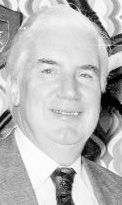Professor James Robson and Dr Ann Lambie
… to follow ……
Professor Sir Michael Woodruff
Professor Sir Michael Woodruff was a pioneer surgeon in organ transplantation. His interest in transplantation began in Singapore when he was captured as a prisoner of war by the Japanese soon after 1942. He held a series of posts at Sheffield, Aberdeen and Otago University (New Zealand) after the war. In 1957, he was appointed to the Chair of Surgical Science (later renamed the University Chair of Surgery) at the University of Edinburgh and Surgeon to the Royal Infirmary of Edinburgh. Sir Michael Woodruff had an interest in transplantation biology, especially on tolerance induction and the immune response to tumours. Within a short time, he established a research centre in the Wilkie Surgical Research Laboratories at the Edinburgh Medical School. It was a centre for research into the clinical and experimental problems on transplantation. Sir Michael Woodruff was appointed the Honorary Director of the Nuffield Transplant Surgery Unit when the Unit was built, and he remained in that post until he retired in 1976. His vision and focus led to remarkable achievements, there is no doubt that his personality also caused him to upset some of his colleagues. Many honours were bestowed upon Sir Michael Woodruff for his outstanding contributions to surgery and to medical science. He was elected to the Fellowship of the Royal Society in 1968, the first surgeon to be so honoured in many years, and he was knighted in 1969.
| “Sir Michael was very enthusiastic. He was an amazing person. He was very supportive of scientists in the medical environment. He saw to it that there were posts established for scientists when he took up the position to head the department. He was one of the first surgeons to make sure that he had scientists in his department.”
Professor Keith James, a scientist who worked with Sir Michael Woodruff |
Life as a Senior House Officer (SHO) in the renal unit in the 1970s
Duties of an SHO included the immediate care of in the dialysis patients with ARF in the Renal Isolation Unit, dialysis patients with CRF at the Medical Renal Unit, patients in the general nephrology ward (ward 21) and patients who boarded in other wards.
Although there were only four patients in the Renal Isolation Unit, they were often very ill and required close monitoring. The workload was heavy as there were plenty of investigations to do. The SHO would do a ward round of the chronic dialysis unit before every dialysis shift. They would see each patient before they started dialysis in order to decide “how much” dialysis they should have, and how much weight should come off. The SHO cannulated many fistulas for vascular access, especially the difficult ones. They supervised every dialysis patient, and put patients on dialysis with the help of the nursing staff. Patients did not have to do anything whereas nowadays, dialysis is more or less a nursing procedure, with patient involvement.
There were only 2 SHOs in the renal unit. They had a 1 in 2 on-call rota. As there were no locums, when the other SHO was ill or away on holiday for 6 weeks per year, the SHO would be continually on-call.


